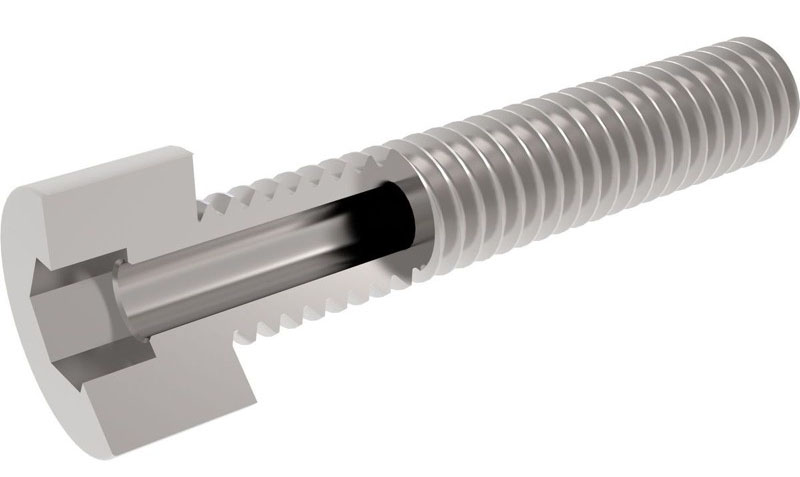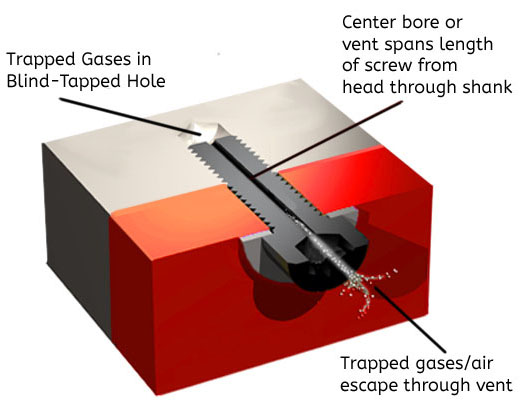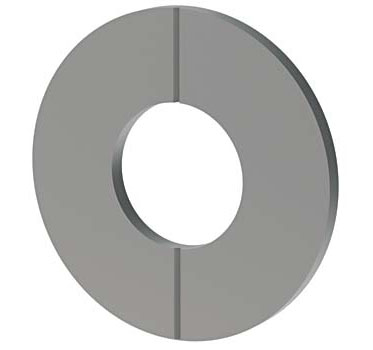Good high temperature oxidation resistance to 2000°F
High temperature stability for moderate strength applications
- Good oxidation and carburization resistant to 2000°F
- Resistance to moderate sulfidation and nitriding
- Economic alternative to high temperature nickel alloys
- 310SS chemistry & specifications
- Features & benefits of 310SS vented screws
- Datasheet for 310 stainless steel
Designed for high temperature applications, 310 stainless steel vented screws provide high temperature oxidation resistance to 2000°F under mild cyclic conditions. An economic alternative to nickel alloys like alloy 330 or Inconel, 310 vented screws provide slightly less strength and temperature resistance – but at a significantly lower price point. Alloy 310 screws can be used in moderately caburizing, moderately oxidizing, nitriding, cementing and thermal cycling applications when not used at the maximum service temperature. 310SS vented screws also have good resistance to sulfidation and other forms of hot corrosion. Although primarily known for its high temperature properties, 310 screws also provide excellent performance at cryogenic temperatures, with toughness down to -450˚F. Though 310 is ideal for high temperature use, it should not be exposed to the severe thermal shock of repeated liquid quenching or where aqueous corrosive contaminants are present.
Benefits
- High temperature resistance.
- Excellent resistance to oxidation under mildly cyclic conditions.
- Good resistance to sulfidation and atmospheres where sulfur dioxide gas is encountered at elevated temperatures.
- Good resistance to thermal fatigue.
- Excellent toughness to cryogenic temperatures of -450°F.
- Low magnetic permeability.
- Good ductility and weldability.
Applications
- Thermal processing and high temperature furnaces rely on 310 vented screws for their high temperature and oxidation resistance in minor cyclic conditions.
- 310SS vented heads are commonly used in the petrochemical industry for their ability to provide resistance to moderately carburizing atmospheres.
- The high temperature properties of 310 screws make them ideal for ore processing, steel plants, power generation, and sintering.
- Cryogenic structures often use 310SS vented screws for their strength at -450°F and low magnetic permeability.
| 310 Stainless Steel Properties | |
| Tensile Strength (ksi) | 70 |
| Yield Strength (ksi) | 30 |
| Rockwell B Hardness | 95 |
| Density (lb/in3) | 0.285 |
| Electrical Resistivity (Microhm-in at 68°C) | 30.7 |
| Modulus of Elasticity (x 106 psi) | 28.5 |
| Thermal Conductivity at 212°F (BTU/hr/ft2/ft/°F) | 8.0 |
Resources: Flange Dimensions, Flange Bolting Chart
Alloy 310 Screw Types: 12 Point Screws, Button Head Cap Screws, Flat Head Screws, Hex Head Cap Screws, Pan Head Screws, Set Screws, Socket Head Cap Screws, Tamper Resistant Security Screws, Torx Screws, Vented Screws
310 Stainless Steel Chemistry & Specifications
310SS Specifications: AMS 5521, AMS 5651, ASME SA 240, ASME SA 312, ASME SA 479, ASTM A 240, ASTM A 276, ASTM A 276 Condition A, ASTM A 276 Condition S, ASTM A 312, ASTM A 479, EN 10095, UNS S31008, UNS S31009, Werkstoff 1.4845

310SS Vented Screw Features & Benefits
310 vented screws are ideal for use in high vacuum (UV) and ultra high vacuum (UHV) equipment, as well as other high pressure environments and applications where gas pockets can form. Center vented screws have a center bore drilled through their axis from the head through the threaded shank of the screw. This feature provides an outlet for the complete evacuation of trapped air and gas contaminants to be pumped away from blind-tapped screw holes, bottoms, sides and shoulders. In addition to vented screws, washers with vent grooves can be made to ensure the venting of the cavity found under the screw head.
310SS Vented Screws Benefits
• Enables faster, more efficient pump-down of HV & UHV systems
• Eliminates virtual leaks • Relieves pressure from blocked gases
• Relieves pressure from blocked gases
• Provides means to vent contaminants found in screw voids
• Promotes higher system throughput and improved yield
• Allows for constant pressure and temperature equalization
310SS Vented Screws Are Available In:
Styles: Socket Head Cap Screw and Hex Head Cap Screw

What is a vented washer?
When a screw is tightened over a flat washer, or directly an application without a washer, volumes of gas can be trapped in the space and beneath the fastener head along the screw shaft. 310 vented washers feature two bored canals on opposite sides of the flat face which provide an escape route for trapped gases.
What is a virtual leak?
A virtual leak is comprised of gases that are trapped physically within a pocket with only a miniscule escape path from the trapped pocket of gas into the chamber proper.
